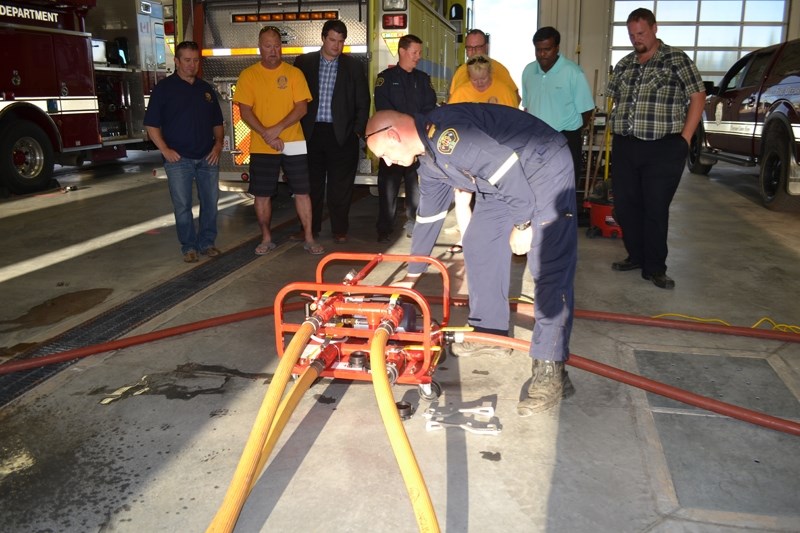Members of the Olds Fire Department and the Rotary Club of Olds got together Aug. 27 to demonstrate a firehose tester.
The $4,000 to $5,000 apparatus can potentially prevent all kinds of injuries including lost limbs, or having no water at a fire scene, firefighters say.
The Rotary Club of Olds paid 100 per cent of the cost for the tester, which has already been put to use and proven its worth since it arrived earlier this year.
Fire Chief Lorne Thompson and Lt. John Lavoie, president of the Olds Firefighters Association, explained the advantages of the tester.
Thompson said previously, firefighters used to test their hoses by hooking them up to a pumper.
That was pretty risky.
“In the old days of testing firehoses, we used to hook it up to the pumper truck itself and then we'd crank the throttle right up and rev it to unbelievable RPM (revolutions per minute) to get the pressure that you needed to test the hose,” he said.
“Then if the hose did fail while we tested it, then it would basically blow and we'd have hose going all over, and it's dangerous and it's really hard on the pumps, so it wasn't a good way.”
Lavoie said under old methods, by sending water through the hose at high testing pressure, if the hose failed by coming off the coupling or blowing a big hole, “someone's losing an eye or someone's losing a leg.”
“If it developed a pinhole leak, that could expand and we could have catastrophic failure, so of course the danger is you have guys in a structural fire situation and the hose fails, and you're going to spray and you've got nothing on the end of the line. You're just gonzo,” Thompson said.
With the tester, Thompson and Lavoie said, water comes through the hose at a high pressure, but so the volume of water that's in there is only the length of the hose. Therefore, if the hose “fails” there's no big volume of water behind it, so nobody gets hurt.
In recent years, Lavoie said, the Olds Fire Department hired a company to test firehoses for them.
“There was that out-of-pocket expense to the taxpayers every year,” he said.
“It's saving us huge, not only in the cost of injury, but also the cost of sending them out to have that done. So it's been a good piece of equipment to have in the hall,” he said.
“The first day we used it after we got it we tested five lengths (of hose) and found five lengths that were all no good, so it's just like that that it happens,” Thompson said. We wouldn't necessarily have known that unless we were really watching at a fire scene and we don't typically do that because we've got other things on our minds (at that time).”
Lavoie cited another case in which the tester proved its worth.
“Of course, with a brand new hose you take it out of the package, put it on the truck, it's good to go, right? Well, we figured we'd just test it; and as we were testing it, the hose walked out of the collar – started to separate from the collar – a brand new hose,” he said.
Money raised via the Rotary Club's Harvest Ball goes toward things like this, Rotary members noted. The next Harvest Ball will take place in October.



